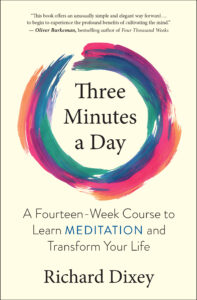Author Richard Dixey, PhD, makes a bold claim in his new book Three Minutes a Day: in just three minutes a day, for fourteen weeks — less than five hours total — you can generate real insight into personal experience that no amount of reading or learning can replicate.
While meditation is known for promoting balance and well-being in our busy lives, it’s typically associated with long periods of sitting. Three Minutes a Day presents a different approach, one that uses short exercises to stabilize mental experience. He lays out a direct path to clarity of mind, stress relief, sharper thinking, improved concentration, and enhanced creativity that can be followed from anywhere, no matter how busy your schedule.
We hope you’ll enjoy this Q & A with Richard about the book.
# # #
Tell us about your book, Three Minutes a Day, and what inspired you to write it.
Three Minutes a Day has two sources. The first is my own training, where short meditation periods were encouraged; the second is my own experience in presenting meditation classes to many people, whether they had already meditated or were completely new to the practice. So why short sessions? Our goal in meditation is to begin to experience our experience as experience itself, rather than looking at what our experience contains. This sounds a little strange at first because we are so used to having experiences of something, rather than experience in and of itself. This means we need to get clear about what we are doing, and do it precisely. The book contains a series of short meditations, with explanations that give background information about them. It’s written so that its insights can become fully embedded in the reader’s experience through the practices and the explanations of them.
Is it really possible to learn meditation in three minutes a day?
As with developing any skill, the key is concentrated repetition. Meditation is unusual, though, as at its core it is a non-doing, a relaxation into a base of cognitive clarity that is already present. To begin such a process, it is helpful to know what one is doing and why, and then to develop a habit that is easy to begin and maintain. The 14 exercises in the book act to build up such a habit and are supported by a simple phone app called Three Minutes to help apply them any time during the day. With those tools, three minutes is fine!
You say that the ability to understand and reduce our reactivity is one of the great fruits of meditation. Tell us more about that, please.
Our reflexive, knee-jerk reactivity is a major element of our experience. We spot something, and immediately we react, often without quite knowing what we are doing. This rapid response serves an important protective function, allowing us to react in light of prior experience to what is happening to us in the present. Although it was of undoubted value when our existence was precarious, it nonetheless comes at a price. Reflexive reactivity is inherently fearful, undermining our ability to rest peacefully and trapping us in responses that necessarily arise from the past. Careful application of moral and ethical principles can modify reactive responses, but they in turn add another layer of control and restraint on top of a deep intuition that almost all people share, the wish to be clear and free. The practice of meditation can cut through this reactivity, gradually disclosing a quiet spaciousness that lies at the heart of every moment. Once it is found, it can be deepened, and that deepening opens to ever-expanding capacities that were before hidden, covered over by reactivity and its consequences.
What are the “three R’s” and how can they help us deal with disruptive thoughts during meditation?
The key to dealing with disruptive thoughts is not to resist them through effort. Rather, it is to invite them, to savor them, and then to let them go and to quietly return to our chosen meditation object. This is the advice of the three R’s: relax, release, and return. Indeed, one of the exercises in Three Minutes a Day is to think deliberately and then stop. By thinking deliberately, we get alongside our thinking process. When we stop thinking, for that brief moment we experience thought-free clarity. Our awareness is still fully present, even though thoughts have stopped. Ultimately we come to see that thoughts are not obstacles, but merely expressions of our creative potentiality.
You encourage your readers to smile during meditation. Why is this important? 
There is a secret here: that a sense of well-being is a favorable condition from which meditative stability can arise. Interestingly, when we allow a faint smile to play across our lips, a sense of well-being arises automatically; it is almost as if the smile and the sensation are linked. Once we discover this, as we sit with a smile, our meditation becomes easier, effortless, and stable.
# # #
Richard Dixey, PhD, is a senior faculty member at Dharma College in Berkeley, California. A research scientist and a lifelong student of Buddhism who holds advanced degrees in biophysics and the history and philosophy of science, Dixey directed a bioelectronic research unit at a London hospital before becoming CEO of his own biotech company. He moved to the US in 2007 to devote himself to teaching meditation, deepening his own practice, and running the Light of Buddhadharma Foundation in India with his wife Wangmo, the eldest daughter of the well-known Tibetan lama Tarthang Tulku. For more information visit him online at http://www.richarddixey.com.
